You are currently browsing the category archive for the ‘Leaving Cert’ category.
I am now available to help students at all levels in the Glanmire and Bishopstown areas.
Contact me on 086-1089437 or jpmccarthymaths@gmail.com.
I am now available to help students at all levels in the Glanmire and Bishopstown areas.
Contact me on 086-1089437 or jpmccarthymaths@gmail.com.
The videos, here, comprise me going through a full Leaving Cert Higher Level Mathematics Paper, namely 2019, Paper 1.
They’re neither slick, perfect, nor as good as I would like them to be.
The videos are labelled in the descriptions, so if you are looking for, say, Q. 5 you can flick through the videos until you find the question you are looking for (e.g. Q. 5 starts at 17.05 here).
All students are looking for help: but perhaps the student that these videos are best placed to help is a student (eventually) going for a H1 who needs something to be explained in more depth, or to give the thought process behind attacking a more challenging problem.
When I say difficult, I mean difficult in comparison to the usual standard of Higher Level Leaving Cert Applied Maths Connected Particles Questions
Question (a)
Consider the following:

A rectangular block moves across a stationary horizontal surface with acceleration (the question had
m/s
but the m/s
is repeated as
m/s
and so includes the unit).
There is a serious problem with this question and that is that the asymmetry in the problem means that there is an ambiguity: is the block moving left to right or right to left? I am going to assume the block moves from left to right. One would hope not to see such ambiguity in an official exam paper.
Two particles of mass placed on the block, are connected by a taut inextensible string. A second string passes over a light, smooth, fixed pulley to a third particle of mass
which presses against the block as shown in the diagram.
(i)
If contact between the particles and the block is smooth, find the magnitude and direction of the resultant forces acting on the particles.
Solution
Note firstly that there are two accelerations at play. The acceleration of the block relative to the horizontal surface, , and the accelerations of the particles relative to the block, say
:

We draw all the forces (I lazily didn’t add arrows to the force vectors):

We know that the normal forces for the particles on top of the block because their vertical acceleration is zero and so the sum of the forces in that direction must be zero, and as the down forces are equal for both, necessarily the up forces must be equal too.
On a particular day the velocity of the wind, in terms of and
, is
, where
.
and
are unit vectors in the directions East and North respectively.
To a man travelling due East the wind appears to come from a direction North West where
.
When he travels due North at the same speed as before, the wind appears to come from a direction North West where
.
Find the actual direction of the wind.
Solution:
We start by writing
.
We have two equations.
Firstly, when the man travels due East, for some constant
. We have
and so
.
We know that this, with respect to the man, is coming from North West. This means we have:
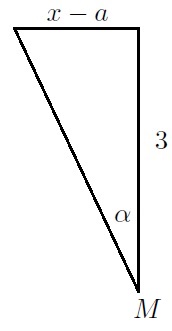
And furthermore:
.
Now consider when the man travels due North, . We have
still and so
.
We know that this, with respect to the man, is coming from North West. This means we have:
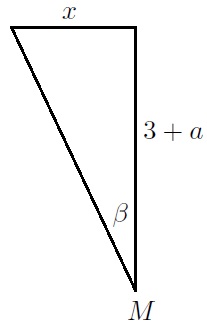
And furthermore:
,
but we have and so
,
so that .
This means that the velocity of the wind looks like:
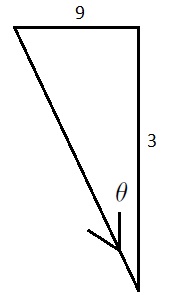
That is the wind comes from North West. We have that
, so the answer to the question asked is N
W.
Here we present three solutions to the one problem. The vector solution is probably the slickest. The geometry solution here can be simplified by being less rigorous, and the coordinate geometry solution might be made easier by using the formula.
LCHL 2007, Q. 2(a)
Ship B is travelling west at 24 km/h. Ship A is travelling north at 32 km/h.
At a certain instant ship B is 8 km north-east of ship A.
(i) Find the velocity of ship A relative to ship B.
(ii) Calculate the length of time, to the nearest minute, for which the ships
are less than or equal to 8 km apart.
Solution to (i): We have that and
and so
.
Vector Approach to (ii)
First of all we draw a picture. As we are talking relative to ship B we will put B at the origin. If ship B is 8 km north-east of ship A then ship A is 8 km south-west of ship B.
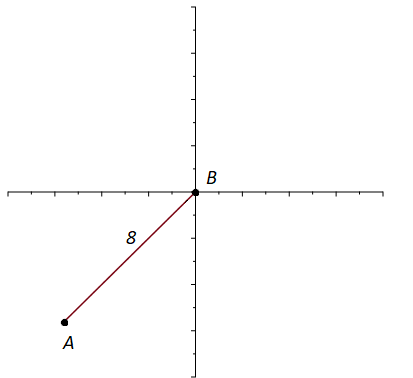
Where is the initial displacement of ship A relative to ship B, the displacement of ship A relative to ship B, as a function of time, is given by
.
Using some trigonometry — vertical and horizontal components of — we have
,
and so
.
The purpose of this post is to briefly discuss parallelism and perpendicularity of lines in both a geometric and algebraic setting.
Lines
What is a line? In Euclidean Geometry we usually don’t define a line and instead call it a primitive object (the properties of lines are then determined by the axioms which refer to them). If instead points and line segments – defined by pairs of points –
are taken as the primitive objects, the following might define lines:
Geometric Definition Candidate
A line,
, is a set of points with the property that for each pair of points in the line,
,
.
In terms of a picture this just says that when you have a line, that if you take two points in the line (the language in comes from set theory), that the line segment is a subset of the line:

Exercise:
Why is this objectively not a good definition of a line.
Once we move into Cartesian\Coordinate Geometry we can perhaps do a similar trick. We can use line segments, and their lengths to define slope, (slope = rise over run) and then define a line as follows:
Algebraic Definition Candidate
A line,
, is a set of points such that for all pairs of distinct points
, the slope is a constant.
This means that if you take two pairs of distinct points in a line , and then calculate the slopes between them, you get the same answer, and therefore it makes sense to talk about the slope of a line,
.

This definition, however, has exactly the same problem as the previous. The definition we use isn’t too important but I do want to use a definition that considers the line a set of points.
The Equation of a Line
We can use such a definition to derive the equation of a line ‘formula’ for a line of slope containing a point
.
Suppose first of all that we have an axis and a point
in the line. What does it take for a second point
to be in the line?
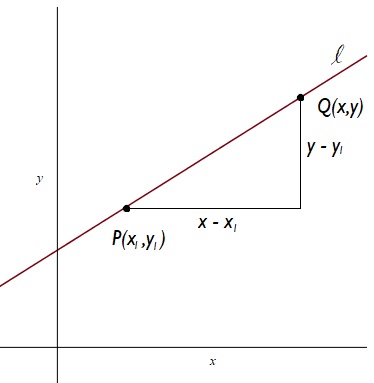
For those planning on focusing on questions one to five and ten:
“Straight-Line-Graph-Through-The-Origin”
The words of Mr Michael Twomey, physics teacher, in Coláiste an Spioraid Naoimh, I can still hear them.
There were two main reasons to produce this straight-line-graph-through-the-origin:
- to measure some quantity (e.g. acceleration due to gravity, speed of sound, etc.)
- to demonstrate some law of nature (e.g. Newton’s Second Law, Ohm’s Law, etc.)
We were correct to draw this straight-line-graph-through-the origin for measurement, but not always, perhaps, in my opinion, for the demonstration of laws of nature.
The purpose of this piece is to explore this in detail.
Direct Proportion
Two variables and
are in direct proportion when there is some (real number) constant
such that
.
Occasionally, it might be useful to do as the title here suggests.
Two examples that spring to mind include:
- solving
for
(relative velocity example with
below)
- maximising
without the use of calculus
Note first of all the similarity between:
.
This identity is in the Department of Education formula booklet.
The only problem is that and
are not necessarily sines and cosines respectively. Consider them, however, as opposites and adjacents to an angle in a right-angled-triangle as shown:

Using Pythagoras Theorem, the hypotenuse is and so if we multiply our expression by
then we have something:
.
Similarly, we have
,
where .

Recent Comments